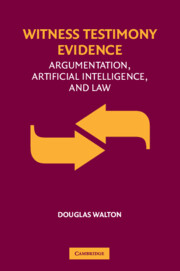Book contents
- Frontmatter
- Contents
- List of Figures and Tables
- Acknowledgments
- Introduction
- 1 Witness Testimony as Argumentation
- 2 Plausible Reasoning in Legal Argumentation
- 3 Scripts, Stories, and Anchored Narratives
- 4 Computational Dialectics
- 5 Witness Examination as Peirastic Dialogue
- 6 Applying Dialectical Models to the Trial
- 7 Supporting and Attacking Witness Testimony
- Bibliography
- Index
3 - Scripts, Stories, and Anchored Narratives
Published online by Cambridge University Press: 03 February 2010
- Frontmatter
- Contents
- List of Figures and Tables
- Acknowledgments
- Introduction
- 1 Witness Testimony as Argumentation
- 2 Plausible Reasoning in Legal Argumentation
- 3 Scripts, Stories, and Anchored Narratives
- 4 Computational Dialectics
- 5 Witness Examination as Peirastic Dialogue
- 6 Applying Dialectical Models to the Trial
- 7 Supporting and Attacking Witness Testimony
- Bibliography
- Index
Summary
To get closer to a useful method of analyzing and evaluating witness testimony as evidence, we need to look more closely at what actually happens in trials. What typically happens in a trial is that when a witness is examined, the examiner will ask a series of connected questions all designed to probe into the particulars of some situation. The answers given by the respondent will tend to hang together in a coherent unity, sometimes called a ‘story’. The use of this term implies a certain skepticism, suggesting that the story may not really be true, and that it may be fabricated, like a fictional story. So when the examiner probes into the story, she may test out its coherence, as well as trying to just elicit further details. At any rate, it seems to be the story itself that guides how the testimony is evaluated as evidence (Bench-Capon and Prakken, 2005). The so-called story is really just the collected set of assertions forming an account of some supposed event reported by the witness. But since the witness is (presumably) in a position to know about the subject he is being questioned about, as shown in Chapter 1, this collected set of assertions can be filtered through argumentation schemes to provide evidence. Because appeal to witness testimony is evidence, presumably based on a rational form of argument, conclusions can be drawn from what the witness says.
- Type
- Chapter
- Information
- Witness Testimony EvidenceArgumentation and the Law, pp. 105 - 150Publisher: Cambridge University PressPrint publication year: 2007



